

 MAKE MAKE
 GOOD GOOD
[Feel free to download these shareables and read
more about
the motivation behind each motif.]
|  
Mowing these letterforms would be nearly impossible at the large scale. I opted to do a modified Helvetica version beneath the mark.

|

Despite the disappointment with my melted field design, I did get some beautiful images of the snow-covered "neighborhood."
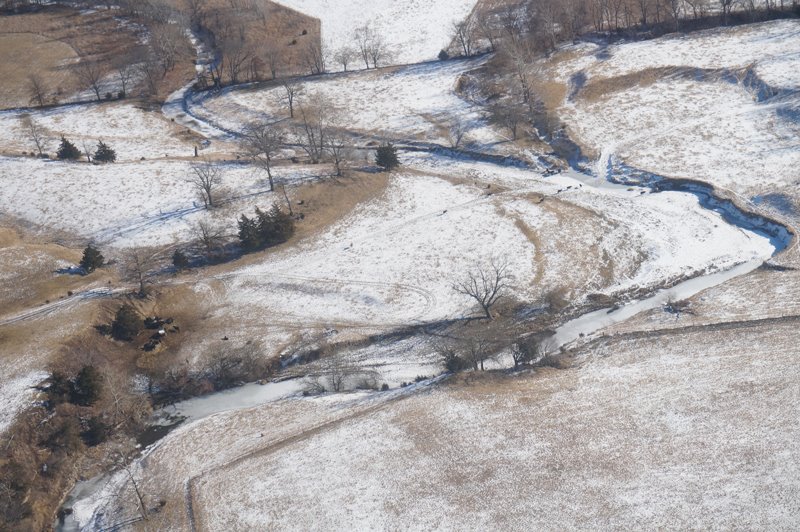
|
|

It's one thing to make all these life changes for myself. It's another to start a dialog about it. My intention is not to push ideology, but to share the experience, the thought process, and the creativity behind the projects that help me reduce my footprint.
The front of my property includes over 3 acres of pasture. A neighbor mows and bales it for hay. The exchange, his cattle get tasty hay and clover during the winter,
I save gas.
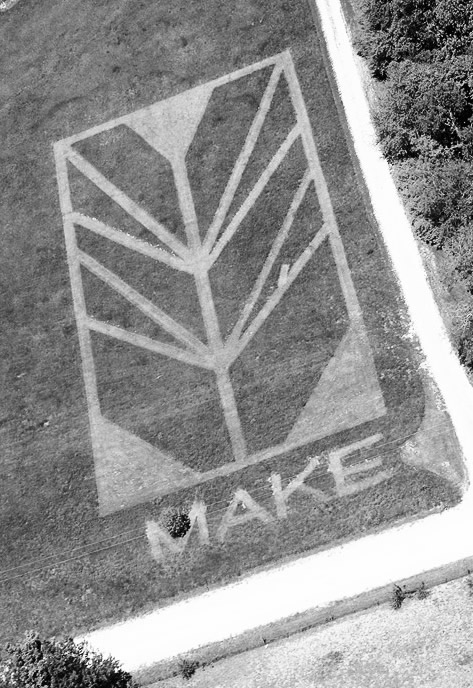
A mower and a field are not the easiest of media to work with. Once the motif design has been determined, I use a Mapquest aerial image of my place to overlay the design onto. Using the legend I'm able to guess-timate a grid assuming each square is 10-square feet.
I used scrap trim wood from my garage to make marker stakes. When I ran out of those I used wire markers with cheesecloth tied on their ends. I used a tape measure and marked off 10-foot increments and marked them with white spray paint. Every 50 feet I'd insert a marker. These were painted red. I discovered that the white cheesecloth blended in with the waving grass tops when I was on the other side of the field. I could see red from 180 feet. The field was marked, time to mow.
I'd start with the perimeter outline, mowing from corner to corner. I tried laying down a rope as a guide to ensure a straight line. It almost got sucked into the mower deck and I decided against that idea. I'd just have to follow the markers and steer straight. If you can't tell from the image at right, I have a zero-turn mower. The front runs freely and the whole thing is driven by the back tires. They drive indepentently of each other allowing me to spin in circles if I wanted. Sometimes I do. My point, the front can also be jarred by bumps. Steering on raw terrain gets a little tricky. Constant correction. I was glad my first motif was nothing but straight lines. I'll confess, this final mowed design did not start this way. I missed my mark on one of the paths, and, after a bit of cussing in the field, I went inside and modified the motif to account for my screw up. I turned out to be better in the end.
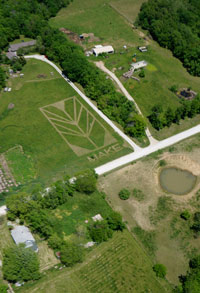 When I first mowed the design the grass was about 10 inches deep. I had almost waited too long. After only a couple of weeks it was nearly 2 feet deep. We had a good dose of rain this spring and everything was healthy and growing fast. I had been talking with colleagues and telling them what I was doing. In describing it I added I was disappointed that it couldn't be seen from the road like I originally intended. I might have to get in the air to see how it really turned out. As I drove home from work that day I decided to stop by a local airport. I was introduced to the Director of Operations, Rob Hackett. I explained what I'd done and that I'd like to fly over the field and take pictures. He seemed pretty excited to do this and we located my place on Google Maps in his office. We would do it the next day. I raced home and mowed the motif one more time to get the best contrast possible for that flight. When I first mowed the design the grass was about 10 inches deep. I had almost waited too long. After only a couple of weeks it was nearly 2 feet deep. We had a good dose of rain this spring and everything was healthy and growing fast. I had been talking with colleagues and telling them what I was doing. In describing it I added I was disappointed that it couldn't be seen from the road like I originally intended. I might have to get in the air to see how it really turned out. As I drove home from work that day I decided to stop by a local airport. I was introduced to the Director of Operations, Rob Hackett. I explained what I'd done and that I'd like to fly over the field and take pictures. He seemed pretty excited to do this and we located my place on Google Maps in his office. We would do it the next day. I raced home and mowed the motif one more time to get the best contrast possible for that flight.
In my excitement to get aerial shots of my field design, I had forgotten a couple of important details. Once we were up off the runway and I saw land slipping away, I said, "did I mention I'm afraid of heights and get motion sick?" Rob looked at me. He was cool as a cucumber. He said, after we'd gotten up to about 1,000 feet, "let me bank the plane your way, because we'll have to in order for you to take pictures, and you tell me how that feels for you." So he did. I'm sure he ended up with half his original space as I know I leaned back into him. "Holy crap!" I thought to myself. Out loud I asked, "can my door come open?" He said no and explained the aerodynamics to me. I felt better but still wished I had more than a lap safety belt to hold me in. "OK, let's do this!"
After about 45 minutes of looping around, with wind gusts thrusting us up and down making some of the photos blurry, I got my photos, and was getting a little motion sick. We headed back to the airport. I thought it odd that it took just as long to fly there in that little plane as it did for me to drive there. The landing made me the most nervous. Little plane, gusts of wind lifting us randomly as if to say, "no, you can't land yet," we were "cock-eyed" at one point, then suddenly, down, and all was good. Whew! That was the most exhilirating, terrifying, fun I'd had in a while. Better than a roller coaster, and I love roller coasters!
The field was ready to be mowed to start over.
My neighbor, Tom, mowed it down, and a couple of days later, baled. I let it grow nearly two weeks before starting the process again. The new motif was a daylily. That meant curves. I wasn't sure how I was going to pull that off.
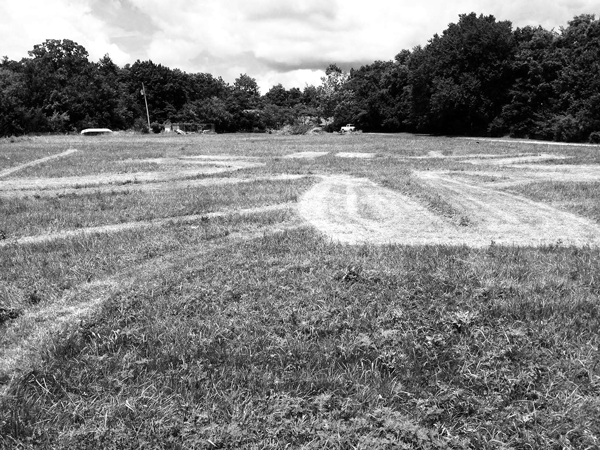
This one took a lot of time, carefully marking strategic transitional spots. I started with the perimeter rectangle again, followed by some of the leaves. I knew they'd be more forgiving. Then came the flower petals. I carried a small printout of the gridded design in my pocket and pulled it out before starting any new swath. I'd double-check my markers. The mower deck was turned on, off, on, off, on, off,...my neighbors were no doubt wondering what I was doing.
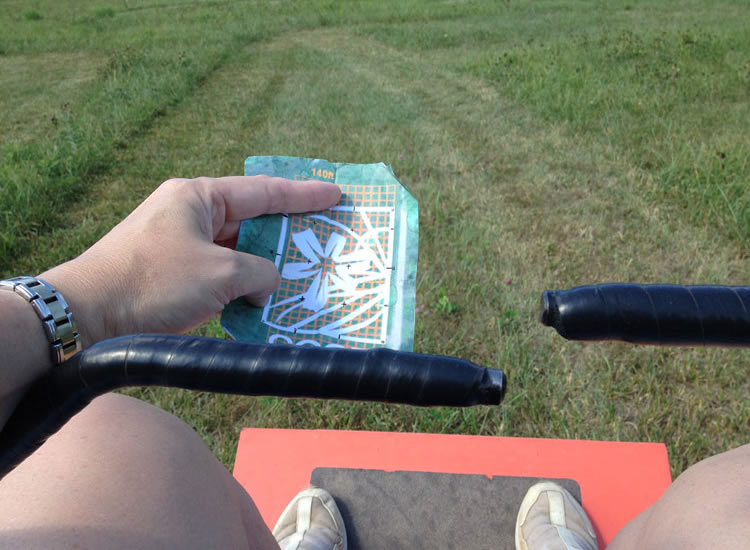
It was mid-summer now and the rains were less frequent. The second growth in the field is mostly red clover. It doesn't grow as tall but is more dense. I had to get out there and maintain the design every two weeks or it would get too thick and bog the mower. I let it grow for several weeks. We went without rain for a while and I thought I was going to lose it. Mother Nature provided, eventually, and it perked back up. It was time to get in the air again. I was running out of semester and wanted to get another motif mowed before heading back to school.
The second pilot, Thomas Alwaret, took us up in a slightly larger plane. It had a bigger engine and a safety strap that crossed my chest. Oh yeah, I felt good about this flight. The engine was so loud we had to wear headphones with microphones. I couldn't resist saying "ladies and gentlemen, please, return your seats and tray tables to an upright position." And we were off.
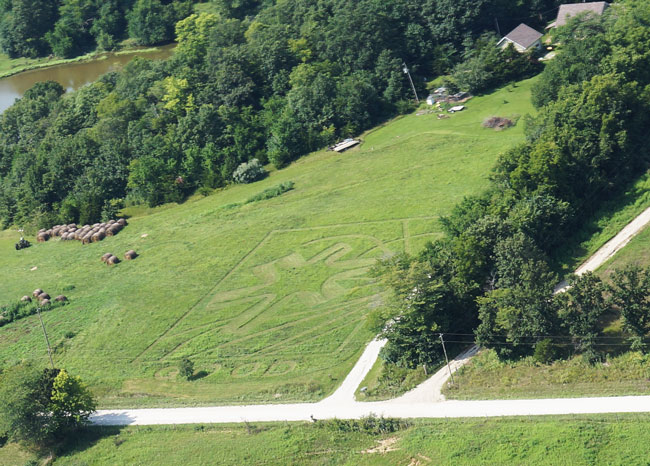
I did get a third design mowed before I headed to school in Vermont in October but did not get in the air to photograph it. I decided to use my Painted Rock mark and mow the letters below it. This late in the season, the grass is shorter, neither clover or hay.
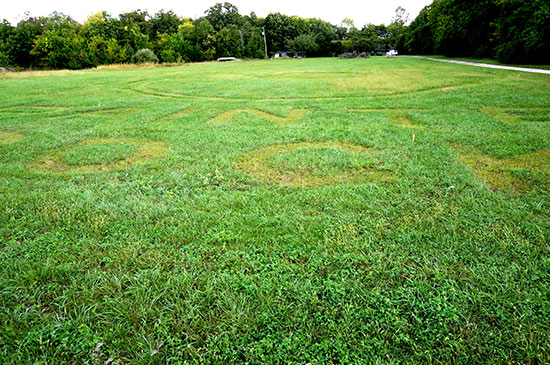
One snowy morning, two days before Christmas, I saw my field design in greater detail.
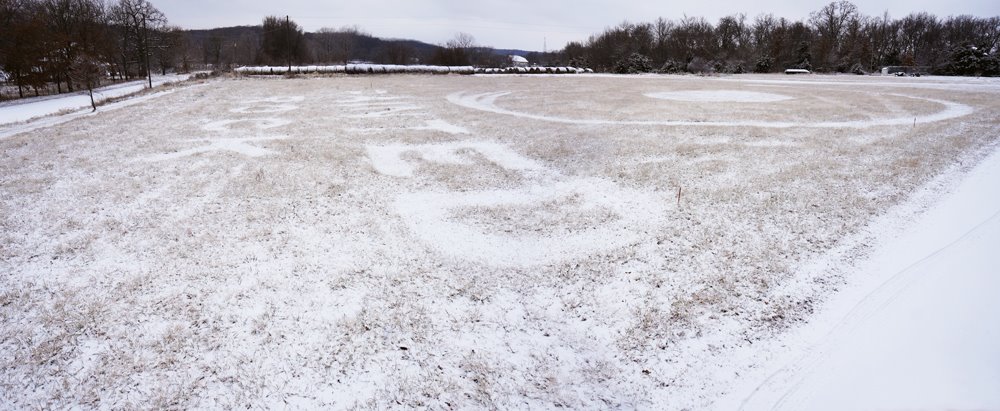
And, the day after Christmas I got up and attempted to capture what was left of the snow on my field design. Sadly, we had a beautiful Christmas day (over 45 degrees) and much of it melted. In the 30 minutes I was airborne all that was left had disappeared leaving a soggy contour.
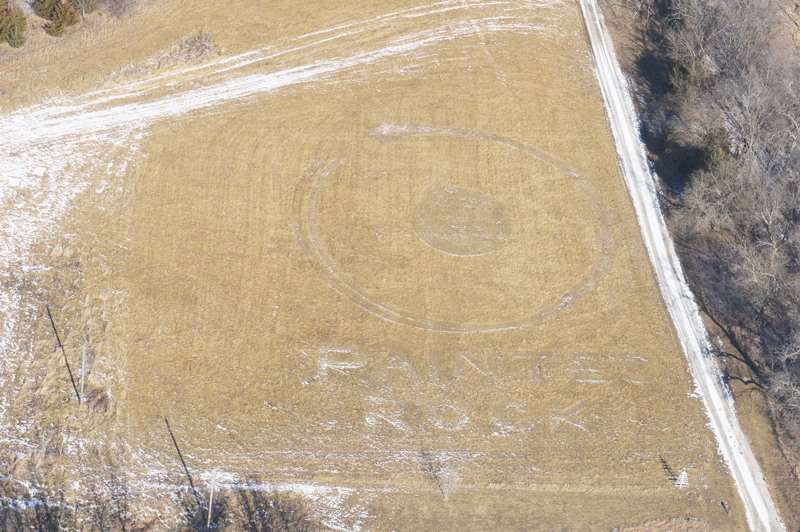
|

